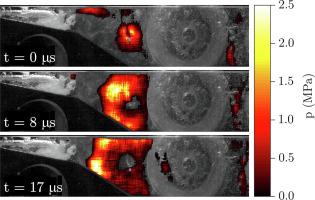当前位置:
X-MOL 学术
›
Exp. Therm. Fluid Sci.
›
论文详情
Our official English website, www.x-mol.net, welcomes your feedback! (Note: you will need to create a separate account there.)
Visualization and measurements of shock waves in cavitating flow
Experimental Thermal and Fluid Science ( IF 3.2 ) Pub Date : 2020-11-01 , DOI: 10.1016/j.expthermflusci.2020.110215 Martin Petkovšek , Marko Hočevar , Matevž Dular
Experimental Thermal and Fluid Science ( IF 3.2 ) Pub Date : 2020-11-01 , DOI: 10.1016/j.expthermflusci.2020.110215 Martin Petkovšek , Marko Hočevar , Matevž Dular

|
Abstract Upon cavitation cloud collapse an omnidirectional shock wave is emitted. It then travels through the flow field, causing a cascade of events resulting in erosion, noise, vibration and the cavitation shedding process. Despite that the accumulated data points evidently to the presence of the shock waves, the direct measurements hardly exist - and even then, they are very expensive and time consuming to perform. In the present paper, the possibility of detecting shock waves inside cavitating flow is shown. The methodology bases on using two conventional high speed cameras. With the first one cavitating flow from a distance is observed, determining the position of the wave, while the second camera with a microscopic lens enables a close-up view to determine the number and size change of air bubbles as a shock wave passed them. By calibration and reference measurements the amplitude of the shock waves was determined. This relatively simple approach enabled the first observation of shockwaves which occur at the cavitation cloud collapse (downstream of the attached cavity). Several examples of shock wave dynamics are shown and how they influence the general cavitation cloud behaviour. Shock wave front velocities and local pressure waves caused by cloud collapse were estimated from visualization, reaching values to more than 700 m/s and over 5 MPa respectively.
中文翻译:

空化流中冲击波的可视化和测量
摘要 空化云坍塌时会发出全方位的冲击波。然后它穿过流场,引起一系列事件,导致侵蚀、噪音、振动和空化脱落过程。尽管积累的数据明显表明存在冲击波,但几乎不存在直接测量——即使如此,它们的执行也非常昂贵且耗时。在本文中,显示了检测空化流内部冲击波的可能性。该方法基于使用两个传统的高速摄像机。第一个从远处观察空化流,确定波的位置,而第二个带有显微镜头的相机可以近距离观察,以确定当冲击波通过气泡时气泡的数量和大小变化。通过校准和参考测量,确定了冲击波的幅度。这种相对简单的方法使第一次观察到发生在空化云坍塌(附属空腔下游)的冲击波。显示了冲击波动力学的几个例子以及它们如何影响一般的空化云行为。通过可视化估计了由云崩塌引起的冲击波前速度和局部压力波,分别达到了超过 700 m/s 和超过 5 MPa 的值。显示了冲击波动力学的几个例子以及它们如何影响一般的空化云行为。通过可视化估计了由云崩塌引起的冲击波前速和局部压力波,分别达到了超过 700 m/s 和超过 5 MPa 的值。显示了冲击波动力学的几个例子以及它们如何影响一般的空化云行为。通过可视化估计了由云崩塌引起的冲击波前速和局部压力波,分别达到了超过 700 m/s 和超过 5 MPa 的值。
更新日期:2020-11-01
中文翻译:

空化流中冲击波的可视化和测量
摘要 空化云坍塌时会发出全方位的冲击波。然后它穿过流场,引起一系列事件,导致侵蚀、噪音、振动和空化脱落过程。尽管积累的数据明显表明存在冲击波,但几乎不存在直接测量——即使如此,它们的执行也非常昂贵且耗时。在本文中,显示了检测空化流内部冲击波的可能性。该方法基于使用两个传统的高速摄像机。第一个从远处观察空化流,确定波的位置,而第二个带有显微镜头的相机可以近距离观察,以确定当冲击波通过气泡时气泡的数量和大小变化。通过校准和参考测量,确定了冲击波的幅度。这种相对简单的方法使第一次观察到发生在空化云坍塌(附属空腔下游)的冲击波。显示了冲击波动力学的几个例子以及它们如何影响一般的空化云行为。通过可视化估计了由云崩塌引起的冲击波前速度和局部压力波,分别达到了超过 700 m/s 和超过 5 MPa 的值。显示了冲击波动力学的几个例子以及它们如何影响一般的空化云行为。通过可视化估计了由云崩塌引起的冲击波前速和局部压力波,分别达到了超过 700 m/s 和超过 5 MPa 的值。显示了冲击波动力学的几个例子以及它们如何影响一般的空化云行为。通过可视化估计了由云崩塌引起的冲击波前速和局部压力波,分别达到了超过 700 m/s 和超过 5 MPa 的值。


























 京公网安备 11010802027423号
京公网安备 11010802027423号